Scenario of Driverless Trucks in Australia: Ethical Theory Application
VerifiedAdded on 2021/06/14
|10
|2522
|35
Report
AI Summary
This report examines the ethical implications of introducing driverless trucks in Australia, focusing on the impact on the transport and logistics industry. It explores the potential disruption to jobs and the economy, particularly considering the utilitarian perspective, which assesses the overall happiness and well-being of the population. The report then delves into deontological ethics, evaluating the rightness or wrongness of the action itself, along with the virtue theory, which emphasizes the character and virtues of the actors involved. Furthermore, the contract theory is applied to analyze the need for agreements and regulations to mitigate negative consequences. The report concludes by synthesizing these ethical frameworks to provide a comprehensive understanding of the moral considerations surrounding the adoption of autonomous trucks in Australia, emphasizing the need for careful consideration of societal impacts and the importance of a balanced approach that benefits all stakeholders. The report also includes a detailed referencing section using APA style.
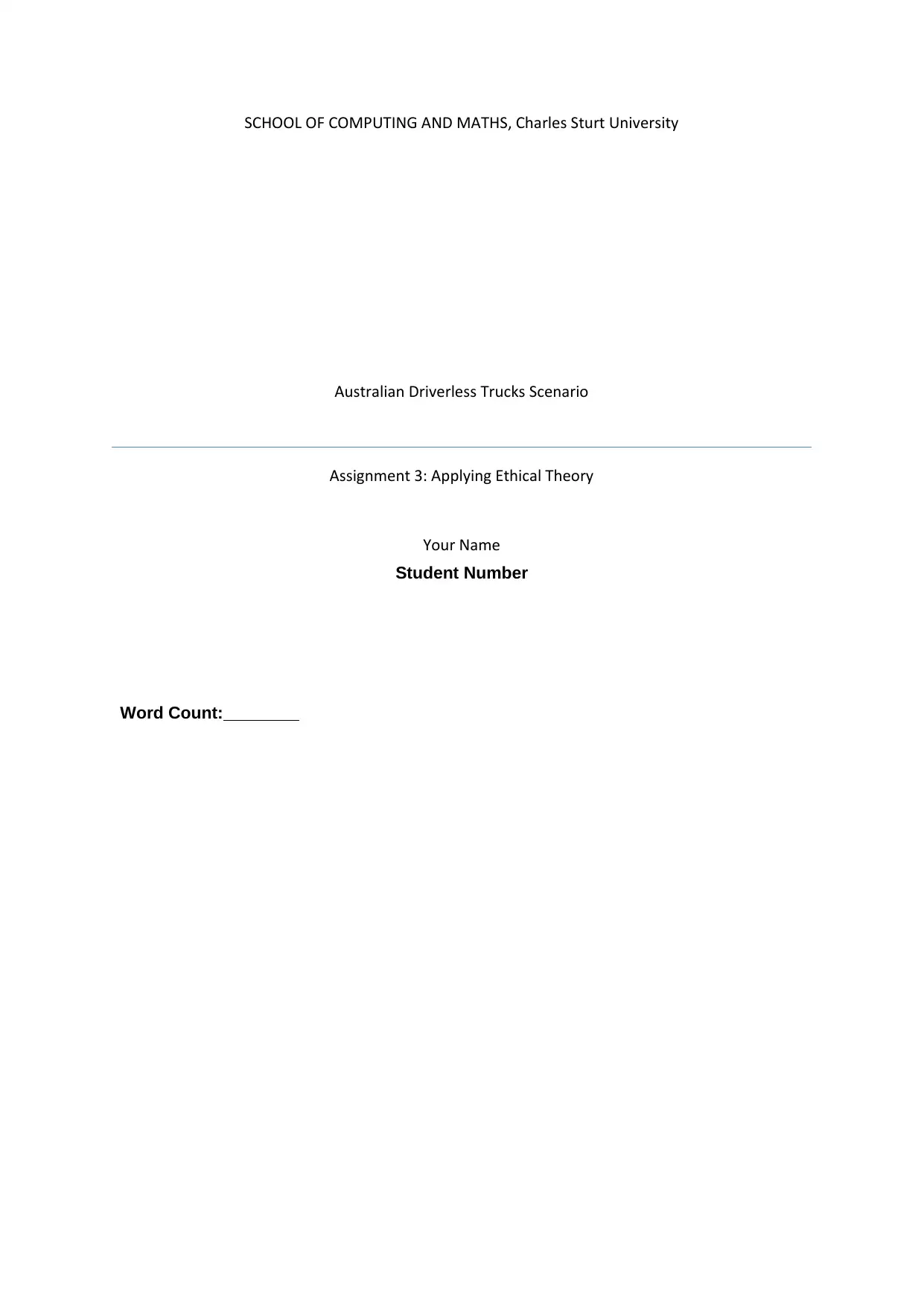
SCHOOL OF COMPUTING AND MATHS, Charles Sturt University
Australian Driverless Trucks Scenario
Assignment 3: Applying Ethical Theory
Your Name
Student Number
Word Count:
Australian Driverless Trucks Scenario
Assignment 3: Applying Ethical Theory
Your Name
Student Number
Word Count:
Paraphrase This Document
Need a fresh take? Get an instant paraphrase of this document with our AI Paraphraser
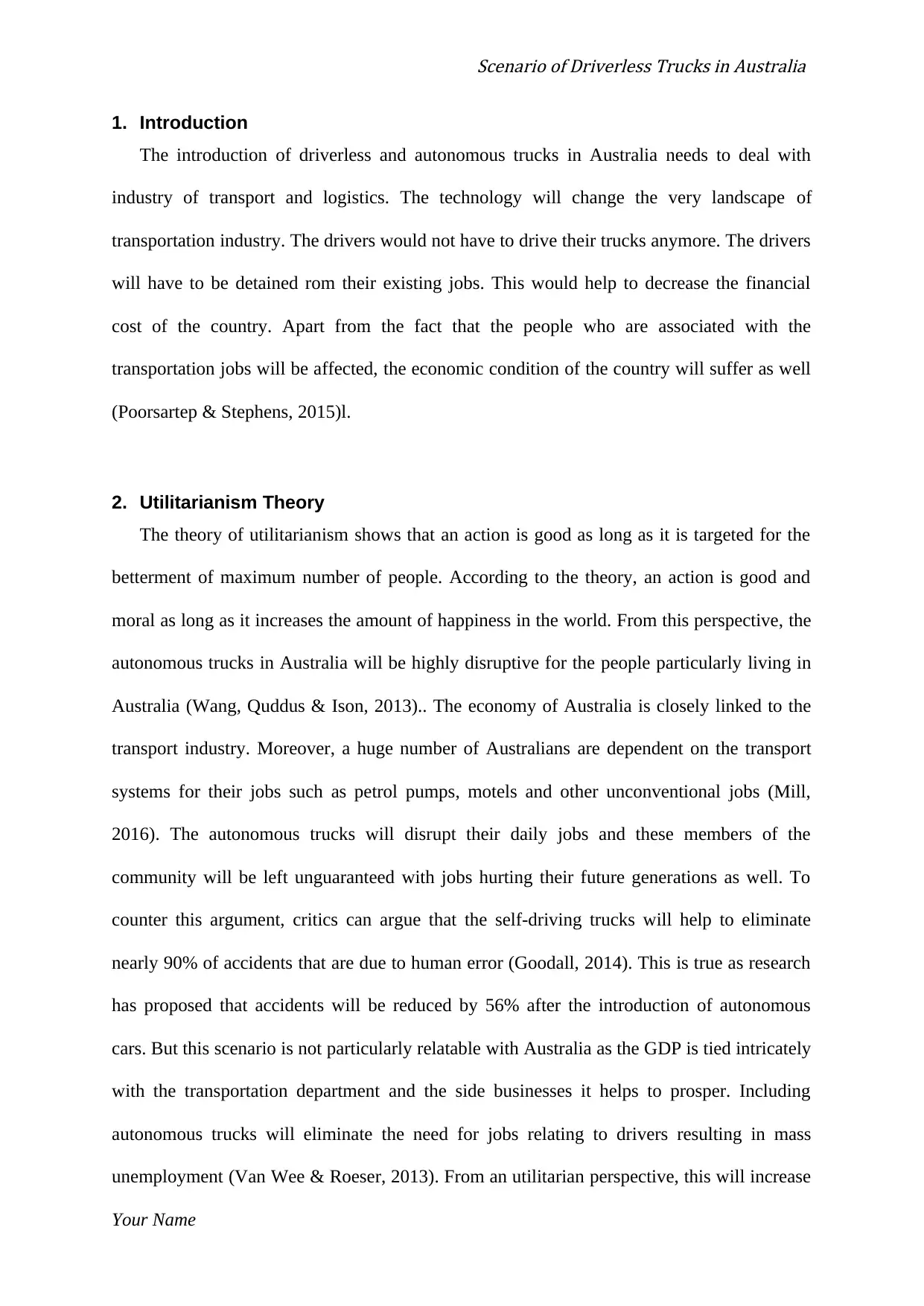
Scenario of Driverless Trucks in Australia
1. Introduction
The introduction of driverless and autonomous trucks in Australia needs to deal with
industry of transport and logistics. The technology will change the very landscape of
transportation industry. The drivers would not have to drive their trucks anymore. The drivers
will have to be detained rom their existing jobs. This would help to decrease the financial
cost of the country. Apart from the fact that the people who are associated with the
transportation jobs will be affected, the economic condition of the country will suffer as well
(Poorsartep & Stephens, 2015)l.
2. Utilitarianism Theory
The theory of utilitarianism shows that an action is good as long as it is targeted for the
betterment of maximum number of people. According to the theory, an action is good and
moral as long as it increases the amount of happiness in the world. From this perspective, the
autonomous trucks in Australia will be highly disruptive for the people particularly living in
Australia (Wang, Quddus & Ison, 2013).. The economy of Australia is closely linked to the
transport industry. Moreover, a huge number of Australians are dependent on the transport
systems for their jobs such as petrol pumps, motels and other unconventional jobs (Mill,
2016). The autonomous trucks will disrupt their daily jobs and these members of the
community will be left unguaranteed with jobs hurting their future generations as well. To
counter this argument, critics can argue that the self-driving trucks will help to eliminate
nearly 90% of accidents that are due to human error (Goodall, 2014). This is true as research
has proposed that accidents will be reduced by 56% after the introduction of autonomous
cars. But this scenario is not particularly relatable with Australia as the GDP is tied intricately
with the transportation department and the side businesses it helps to prosper. Including
autonomous trucks will eliminate the need for jobs relating to drivers resulting in mass
unemployment (Van Wee & Roeser, 2013). From an utilitarian perspective, this will increase
Your Name
1. Introduction
The introduction of driverless and autonomous trucks in Australia needs to deal with
industry of transport and logistics. The technology will change the very landscape of
transportation industry. The drivers would not have to drive their trucks anymore. The drivers
will have to be detained rom their existing jobs. This would help to decrease the financial
cost of the country. Apart from the fact that the people who are associated with the
transportation jobs will be affected, the economic condition of the country will suffer as well
(Poorsartep & Stephens, 2015)l.
2. Utilitarianism Theory
The theory of utilitarianism shows that an action is good as long as it is targeted for the
betterment of maximum number of people. According to the theory, an action is good and
moral as long as it increases the amount of happiness in the world. From this perspective, the
autonomous trucks in Australia will be highly disruptive for the people particularly living in
Australia (Wang, Quddus & Ison, 2013).. The economy of Australia is closely linked to the
transport industry. Moreover, a huge number of Australians are dependent on the transport
systems for their jobs such as petrol pumps, motels and other unconventional jobs (Mill,
2016). The autonomous trucks will disrupt their daily jobs and these members of the
community will be left unguaranteed with jobs hurting their future generations as well. To
counter this argument, critics can argue that the self-driving trucks will help to eliminate
nearly 90% of accidents that are due to human error (Goodall, 2014). This is true as research
has proposed that accidents will be reduced by 56% after the introduction of autonomous
cars. But this scenario is not particularly relatable with Australia as the GDP is tied intricately
with the transportation department and the side businesses it helps to prosper. Including
autonomous trucks will eliminate the need for jobs relating to drivers resulting in mass
unemployment (Van Wee & Roeser, 2013). From an utilitarian perspective, this will increase
Your Name
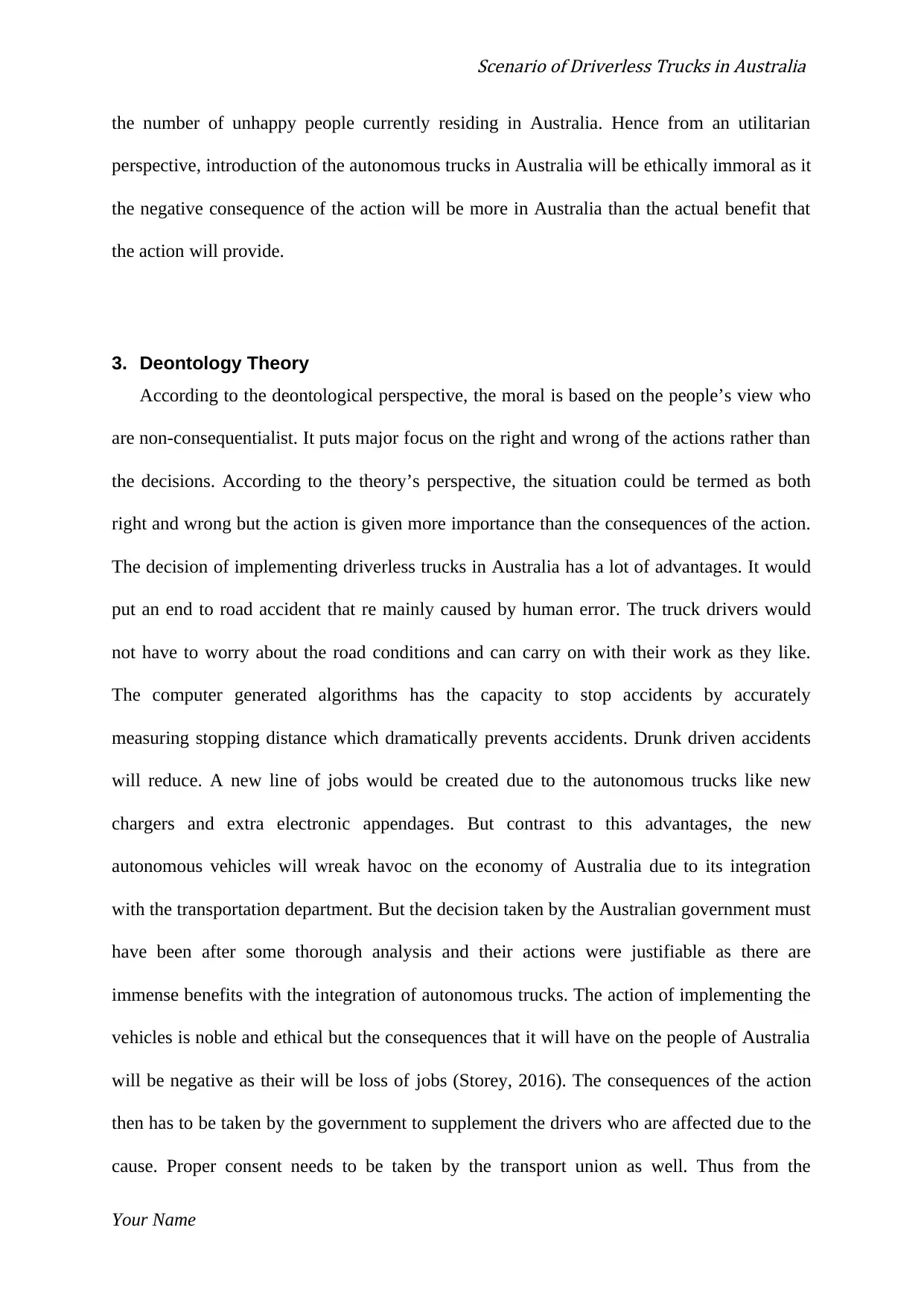
Scenario of Driverless Trucks in Australia
the number of unhappy people currently residing in Australia. Hence from an utilitarian
perspective, introduction of the autonomous trucks in Australia will be ethically immoral as it
the negative consequence of the action will be more in Australia than the actual benefit that
the action will provide.
3. Deontology Theory
According to the deontological perspective, the moral is based on the people’s view who
are non-consequentialist. It puts major focus on the right and wrong of the actions rather than
the decisions. According to the theory’s perspective, the situation could be termed as both
right and wrong but the action is given more importance than the consequences of the action.
The decision of implementing driverless trucks in Australia has a lot of advantages. It would
put an end to road accident that re mainly caused by human error. The truck drivers would
not have to worry about the road conditions and can carry on with their work as they like.
The computer generated algorithms has the capacity to stop accidents by accurately
measuring stopping distance which dramatically prevents accidents. Drunk driven accidents
will reduce. A new line of jobs would be created due to the autonomous trucks like new
chargers and extra electronic appendages. But contrast to this advantages, the new
autonomous vehicles will wreak havoc on the economy of Australia due to its integration
with the transportation department. But the decision taken by the Australian government must
have been after some thorough analysis and their actions were justifiable as there are
immense benefits with the integration of autonomous trucks. The action of implementing the
vehicles is noble and ethical but the consequences that it will have on the people of Australia
will be negative as their will be loss of jobs (Storey, 2016). The consequences of the action
then has to be taken by the government to supplement the drivers who are affected due to the
cause. Proper consent needs to be taken by the transport union as well. Thus from the
Your Name
the number of unhappy people currently residing in Australia. Hence from an utilitarian
perspective, introduction of the autonomous trucks in Australia will be ethically immoral as it
the negative consequence of the action will be more in Australia than the actual benefit that
the action will provide.
3. Deontology Theory
According to the deontological perspective, the moral is based on the people’s view who
are non-consequentialist. It puts major focus on the right and wrong of the actions rather than
the decisions. According to the theory’s perspective, the situation could be termed as both
right and wrong but the action is given more importance than the consequences of the action.
The decision of implementing driverless trucks in Australia has a lot of advantages. It would
put an end to road accident that re mainly caused by human error. The truck drivers would
not have to worry about the road conditions and can carry on with their work as they like.
The computer generated algorithms has the capacity to stop accidents by accurately
measuring stopping distance which dramatically prevents accidents. Drunk driven accidents
will reduce. A new line of jobs would be created due to the autonomous trucks like new
chargers and extra electronic appendages. But contrast to this advantages, the new
autonomous vehicles will wreak havoc on the economy of Australia due to its integration
with the transportation department. But the decision taken by the Australian government must
have been after some thorough analysis and their actions were justifiable as there are
immense benefits with the integration of autonomous trucks. The action of implementing the
vehicles is noble and ethical but the consequences that it will have on the people of Australia
will be negative as their will be loss of jobs (Storey, 2016). The consequences of the action
then has to be taken by the government to supplement the drivers who are affected due to the
cause. Proper consent needs to be taken by the transport union as well. Thus from the
Your Name
⊘ This is a preview!⊘
Do you want full access?
Subscribe today to unlock all pages.

Trusted by 1+ million students worldwide
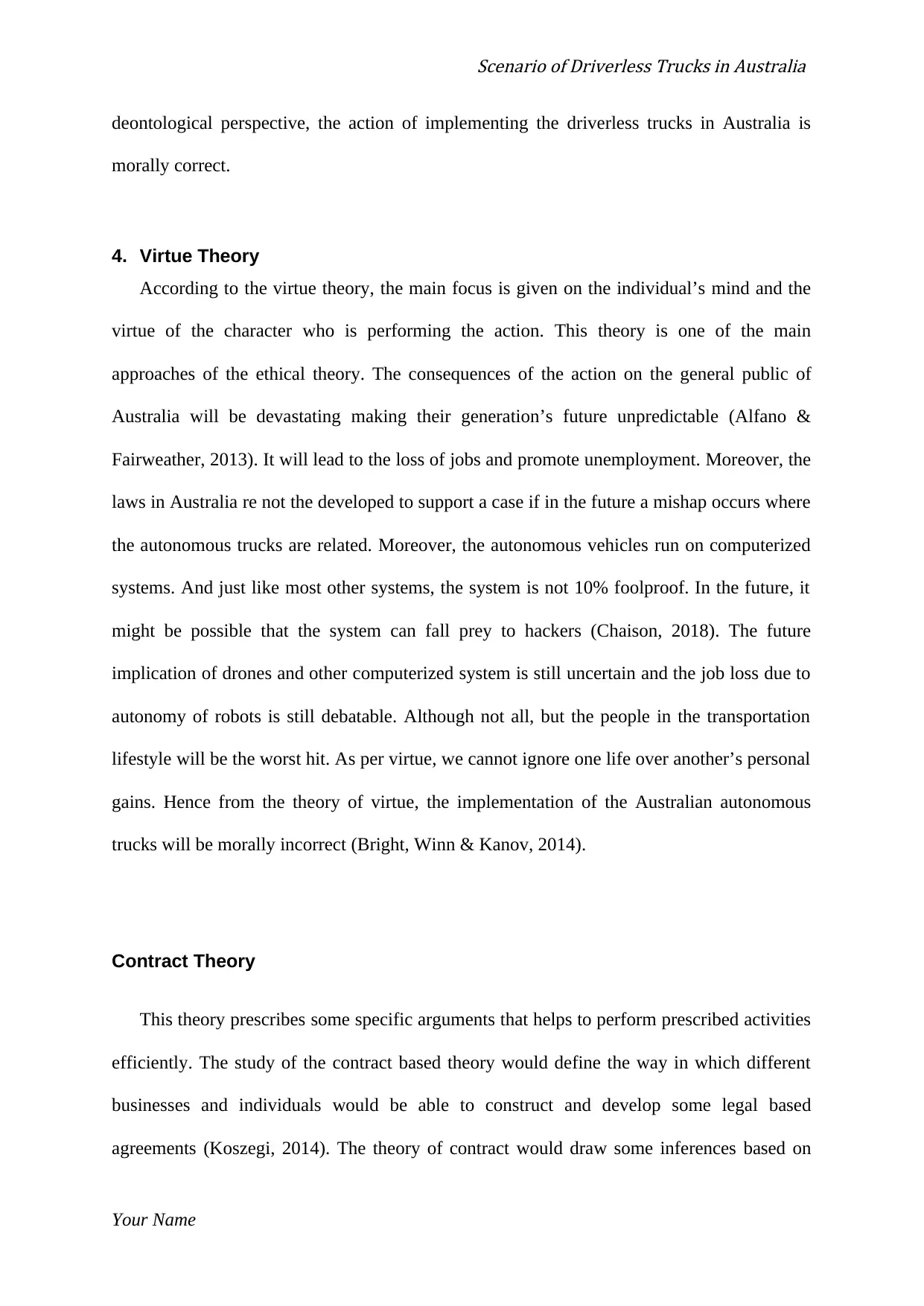
Scenario of Driverless Trucks in Australia
deontological perspective, the action of implementing the driverless trucks in Australia is
morally correct.
4. Virtue Theory
According to the virtue theory, the main focus is given on the individual’s mind and the
virtue of the character who is performing the action. This theory is one of the main
approaches of the ethical theory. The consequences of the action on the general public of
Australia will be devastating making their generation’s future unpredictable (Alfano &
Fairweather, 2013). It will lead to the loss of jobs and promote unemployment. Moreover, the
laws in Australia re not the developed to support a case if in the future a mishap occurs where
the autonomous trucks are related. Moreover, the autonomous vehicles run on computerized
systems. And just like most other systems, the system is not 10% foolproof. In the future, it
might be possible that the system can fall prey to hackers (Chaison, 2018). The future
implication of drones and other computerized system is still uncertain and the job loss due to
autonomy of robots is still debatable. Although not all, but the people in the transportation
lifestyle will be the worst hit. As per virtue, we cannot ignore one life over another’s personal
gains. Hence from the theory of virtue, the implementation of the Australian autonomous
trucks will be morally incorrect (Bright, Winn & Kanov, 2014).
Contract Theory
This theory prescribes some specific arguments that helps to perform prescribed activities
efficiently. The study of the contract based theory would define the way in which different
businesses and individuals would be able to construct and develop some legal based
agreements (Koszegi, 2014). The theory of contract would draw some inferences based on
Your Name
deontological perspective, the action of implementing the driverless trucks in Australia is
morally correct.
4. Virtue Theory
According to the virtue theory, the main focus is given on the individual’s mind and the
virtue of the character who is performing the action. This theory is one of the main
approaches of the ethical theory. The consequences of the action on the general public of
Australia will be devastating making their generation’s future unpredictable (Alfano &
Fairweather, 2013). It will lead to the loss of jobs and promote unemployment. Moreover, the
laws in Australia re not the developed to support a case if in the future a mishap occurs where
the autonomous trucks are related. Moreover, the autonomous vehicles run on computerized
systems. And just like most other systems, the system is not 10% foolproof. In the future, it
might be possible that the system can fall prey to hackers (Chaison, 2018). The future
implication of drones and other computerized system is still uncertain and the job loss due to
autonomy of robots is still debatable. Although not all, but the people in the transportation
lifestyle will be the worst hit. As per virtue, we cannot ignore one life over another’s personal
gains. Hence from the theory of virtue, the implementation of the Australian autonomous
trucks will be morally incorrect (Bright, Winn & Kanov, 2014).
Contract Theory
This theory prescribes some specific arguments that helps to perform prescribed activities
efficiently. The study of the contract based theory would define the way in which different
businesses and individuals would be able to construct and develop some legal based
agreements (Koszegi, 2014). The theory of contract would draw some inferences based on
Your Name
Paraphrase This Document
Need a fresh take? Get an instant paraphrase of this document with our AI Paraphraser
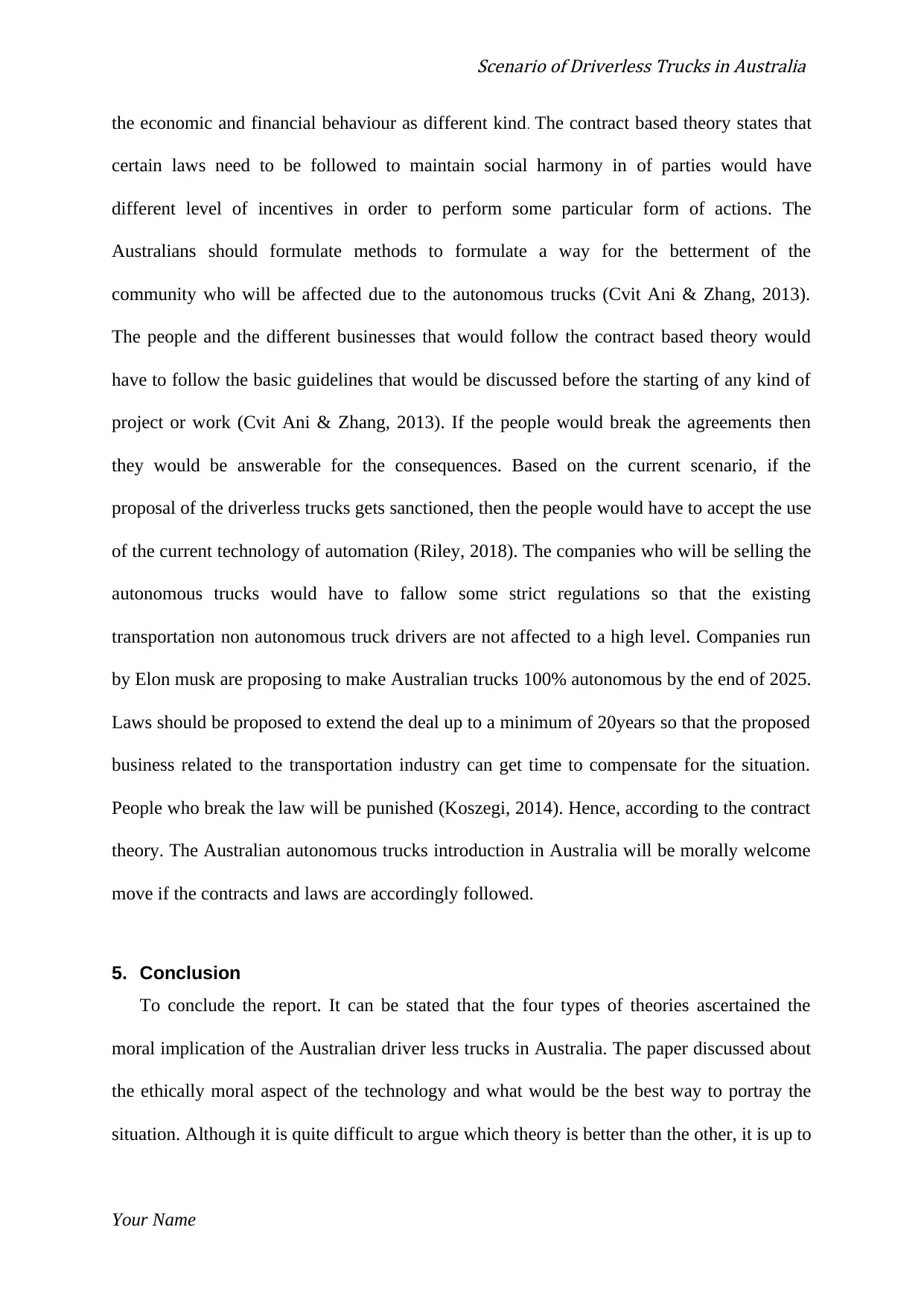
Scenario of Driverless Trucks in Australia
the economic and financial behaviour as different kind. The contract based theory states that
certain laws need to be followed to maintain social harmony in of parties would have
different level of incentives in order to perform some particular form of actions. The
Australians should formulate methods to formulate a way for the betterment of the
community who will be affected due to the autonomous trucks (Cvit Ani & Zhang, 2013).
The people and the different businesses that would follow the contract based theory would
have to follow the basic guidelines that would be discussed before the starting of any kind of
project or work (Cvit Ani & Zhang, 2013). If the people would break the agreements then
they would be answerable for the consequences. Based on the current scenario, if the
proposal of the driverless trucks gets sanctioned, then the people would have to accept the use
of the current technology of automation (Riley, 2018). The companies who will be selling the
autonomous trucks would have to fallow some strict regulations so that the existing
transportation non autonomous truck drivers are not affected to a high level. Companies run
by Elon musk are proposing to make Australian trucks 100% autonomous by the end of 2025.
Laws should be proposed to extend the deal up to a minimum of 20years so that the proposed
business related to the transportation industry can get time to compensate for the situation.
People who break the law will be punished (Koszegi, 2014). Hence, according to the contract
theory. The Australian autonomous trucks introduction in Australia will be morally welcome
move if the contracts and laws are accordingly followed.
5. Conclusion
To conclude the report. It can be stated that the four types of theories ascertained the
moral implication of the Australian driver less trucks in Australia. The paper discussed about
the ethically moral aspect of the technology and what would be the best way to portray the
situation. Although it is quite difficult to argue which theory is better than the other, it is up to
Your Name
the economic and financial behaviour as different kind. The contract based theory states that
certain laws need to be followed to maintain social harmony in of parties would have
different level of incentives in order to perform some particular form of actions. The
Australians should formulate methods to formulate a way for the betterment of the
community who will be affected due to the autonomous trucks (Cvit Ani & Zhang, 2013).
The people and the different businesses that would follow the contract based theory would
have to follow the basic guidelines that would be discussed before the starting of any kind of
project or work (Cvit Ani & Zhang, 2013). If the people would break the agreements then
they would be answerable for the consequences. Based on the current scenario, if the
proposal of the driverless trucks gets sanctioned, then the people would have to accept the use
of the current technology of automation (Riley, 2018). The companies who will be selling the
autonomous trucks would have to fallow some strict regulations so that the existing
transportation non autonomous truck drivers are not affected to a high level. Companies run
by Elon musk are proposing to make Australian trucks 100% autonomous by the end of 2025.
Laws should be proposed to extend the deal up to a minimum of 20years so that the proposed
business related to the transportation industry can get time to compensate for the situation.
People who break the law will be punished (Koszegi, 2014). Hence, according to the contract
theory. The Australian autonomous trucks introduction in Australia will be morally welcome
move if the contracts and laws are accordingly followed.
5. Conclusion
To conclude the report. It can be stated that the four types of theories ascertained the
moral implication of the Australian driver less trucks in Australia. The paper discussed about
the ethically moral aspect of the technology and what would be the best way to portray the
situation. Although it is quite difficult to argue which theory is better than the other, it is up to
Your Name
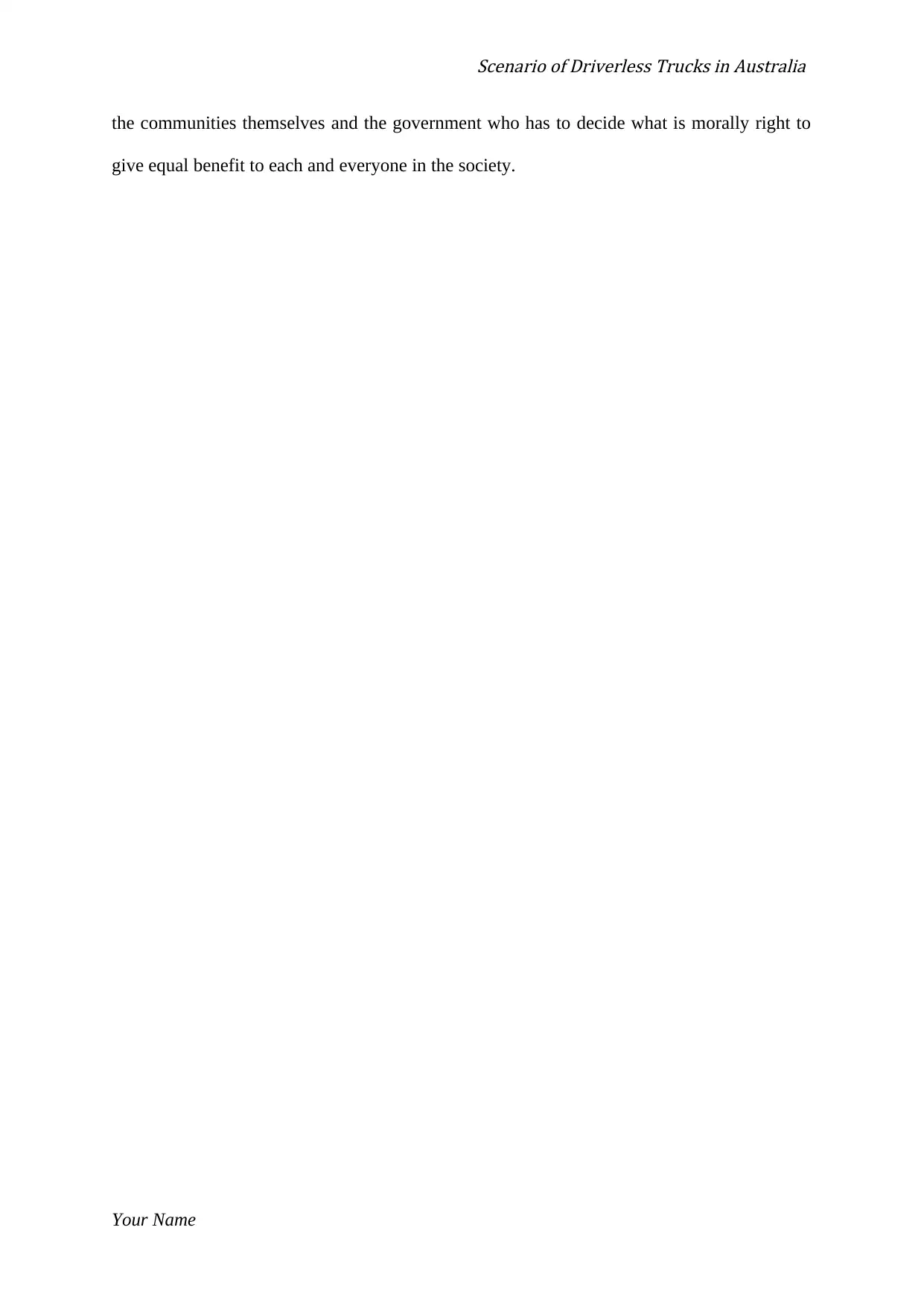
Scenario of Driverless Trucks in Australia
the communities themselves and the government who has to decide what is morally right to
give equal benefit to each and everyone in the society.
Your Name
the communities themselves and the government who has to decide what is morally right to
give equal benefit to each and everyone in the society.
Your Name
⊘ This is a preview!⊘
Do you want full access?
Subscribe today to unlock all pages.

Trusted by 1+ million students worldwide
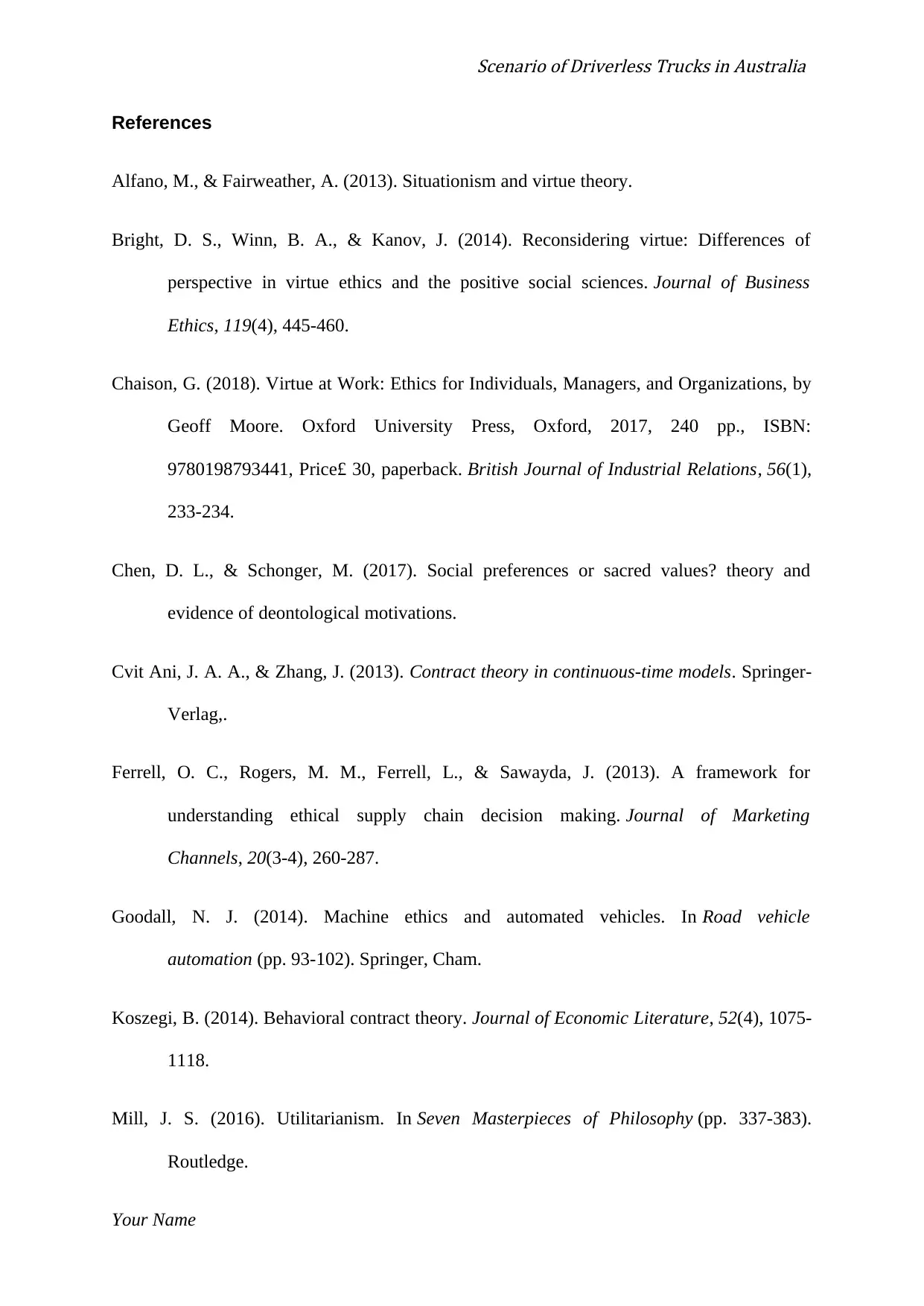
Scenario of Driverless Trucks in Australia
References
Alfano, M., & Fairweather, A. (2013). Situationism and virtue theory.
Bright, D. S., Winn, B. A., & Kanov, J. (2014). Reconsidering virtue: Differences of
perspective in virtue ethics and the positive social sciences. Journal of Business
Ethics, 119(4), 445-460.
Chaison, G. (2018). Virtue at Work: Ethics for Individuals, Managers, and Organizations, by
Geoff Moore. Oxford University Press, Oxford, 2017, 240 pp., ISBN:
9780198793441, Price£ 30, paperback. British Journal of Industrial Relations, 56(1),
233-234.
Chen, D. L., & Schonger, M. (2017). Social preferences or sacred values? theory and
evidence of deontological motivations.
Cvit Ani, J. A. A., & Zhang, J. (2013). Contract theory in continuous-time models. Springer-
Verlag,.
Ferrell, O. C., Rogers, M. M., Ferrell, L., & Sawayda, J. (2013). A framework for
understanding ethical supply chain decision making. Journal of Marketing
Channels, 20(3-4), 260-287.
Goodall, N. J. (2014). Machine ethics and automated vehicles. In Road vehicle
automation (pp. 93-102). Springer, Cham.
Koszegi, B. (2014). Behavioral contract theory. Journal of Economic Literature, 52(4), 1075-
1118.
Mill, J. S. (2016). Utilitarianism. In Seven Masterpieces of Philosophy (pp. 337-383).
Routledge.
Your Name
References
Alfano, M., & Fairweather, A. (2013). Situationism and virtue theory.
Bright, D. S., Winn, B. A., & Kanov, J. (2014). Reconsidering virtue: Differences of
perspective in virtue ethics and the positive social sciences. Journal of Business
Ethics, 119(4), 445-460.
Chaison, G. (2018). Virtue at Work: Ethics for Individuals, Managers, and Organizations, by
Geoff Moore. Oxford University Press, Oxford, 2017, 240 pp., ISBN:
9780198793441, Price£ 30, paperback. British Journal of Industrial Relations, 56(1),
233-234.
Chen, D. L., & Schonger, M. (2017). Social preferences or sacred values? theory and
evidence of deontological motivations.
Cvit Ani, J. A. A., & Zhang, J. (2013). Contract theory in continuous-time models. Springer-
Verlag,.
Ferrell, O. C., Rogers, M. M., Ferrell, L., & Sawayda, J. (2013). A framework for
understanding ethical supply chain decision making. Journal of Marketing
Channels, 20(3-4), 260-287.
Goodall, N. J. (2014). Machine ethics and automated vehicles. In Road vehicle
automation (pp. 93-102). Springer, Cham.
Koszegi, B. (2014). Behavioral contract theory. Journal of Economic Literature, 52(4), 1075-
1118.
Mill, J. S. (2016). Utilitarianism. In Seven Masterpieces of Philosophy (pp. 337-383).
Routledge.
Your Name
Paraphrase This Document
Need a fresh take? Get an instant paraphrase of this document with our AI Paraphraser
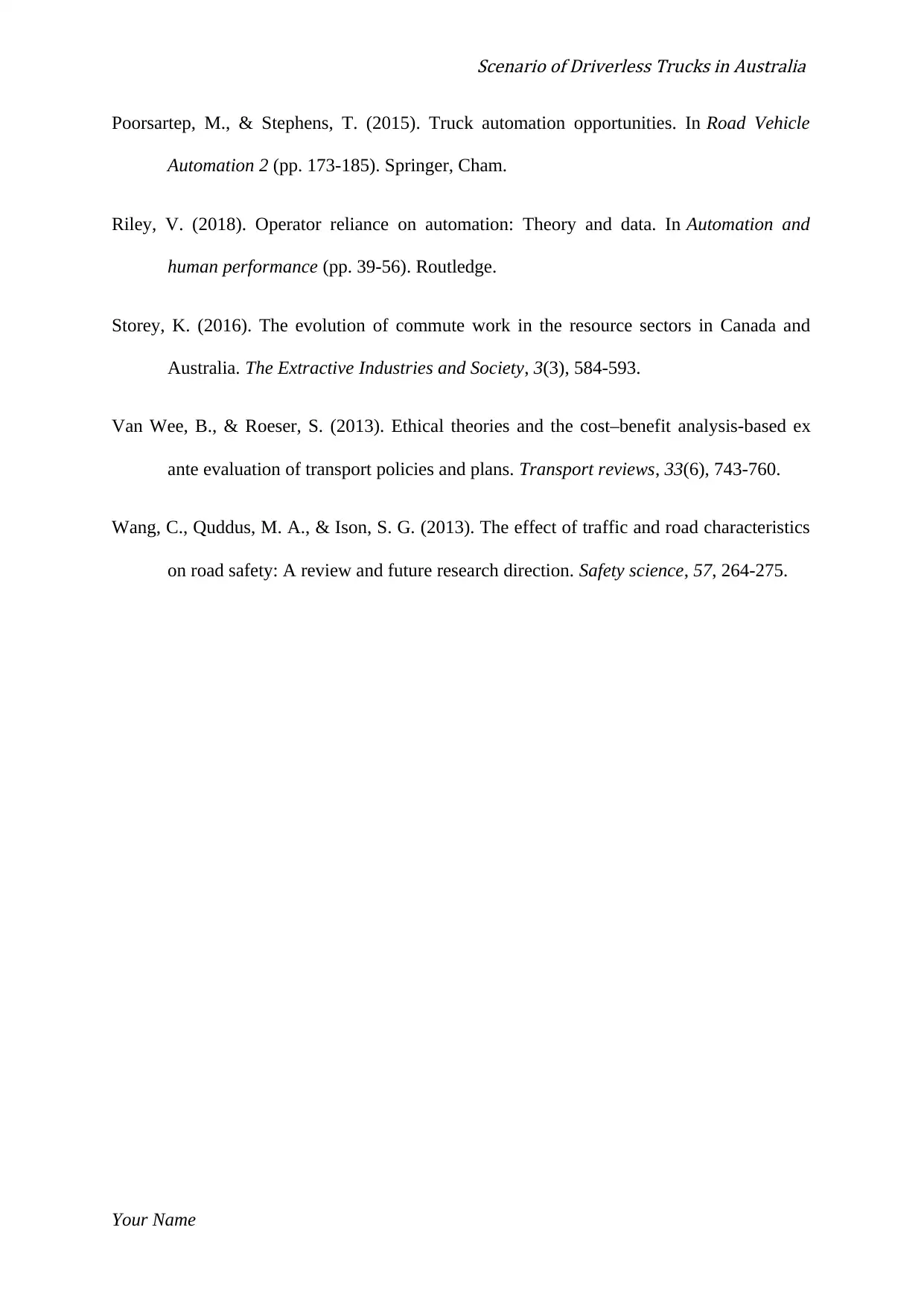
Scenario of Driverless Trucks in Australia
Poorsartep, M., & Stephens, T. (2015). Truck automation opportunities. In Road Vehicle
Automation 2 (pp. 173-185). Springer, Cham.
Riley, V. (2018). Operator reliance on automation: Theory and data. In Automation and
human performance (pp. 39-56). Routledge.
Storey, K. (2016). The evolution of commute work in the resource sectors in Canada and
Australia. The Extractive Industries and Society, 3(3), 584-593.
Van Wee, B., & Roeser, S. (2013). Ethical theories and the cost–benefit analysis-based ex
ante evaluation of transport policies and plans. Transport reviews, 33(6), 743-760.
Wang, C., Quddus, M. A., & Ison, S. G. (2013). The effect of traffic and road characteristics
on road safety: A review and future research direction. Safety science, 57, 264-275.
Your Name
Poorsartep, M., & Stephens, T. (2015). Truck automation opportunities. In Road Vehicle
Automation 2 (pp. 173-185). Springer, Cham.
Riley, V. (2018). Operator reliance on automation: Theory and data. In Automation and
human performance (pp. 39-56). Routledge.
Storey, K. (2016). The evolution of commute work in the resource sectors in Canada and
Australia. The Extractive Industries and Society, 3(3), 584-593.
Van Wee, B., & Roeser, S. (2013). Ethical theories and the cost–benefit analysis-based ex
ante evaluation of transport policies and plans. Transport reviews, 33(6), 743-760.
Wang, C., Quddus, M. A., & Ison, S. G. (2013). The effect of traffic and road characteristics
on road safety: A review and future research direction. Safety science, 57, 264-275.
Your Name
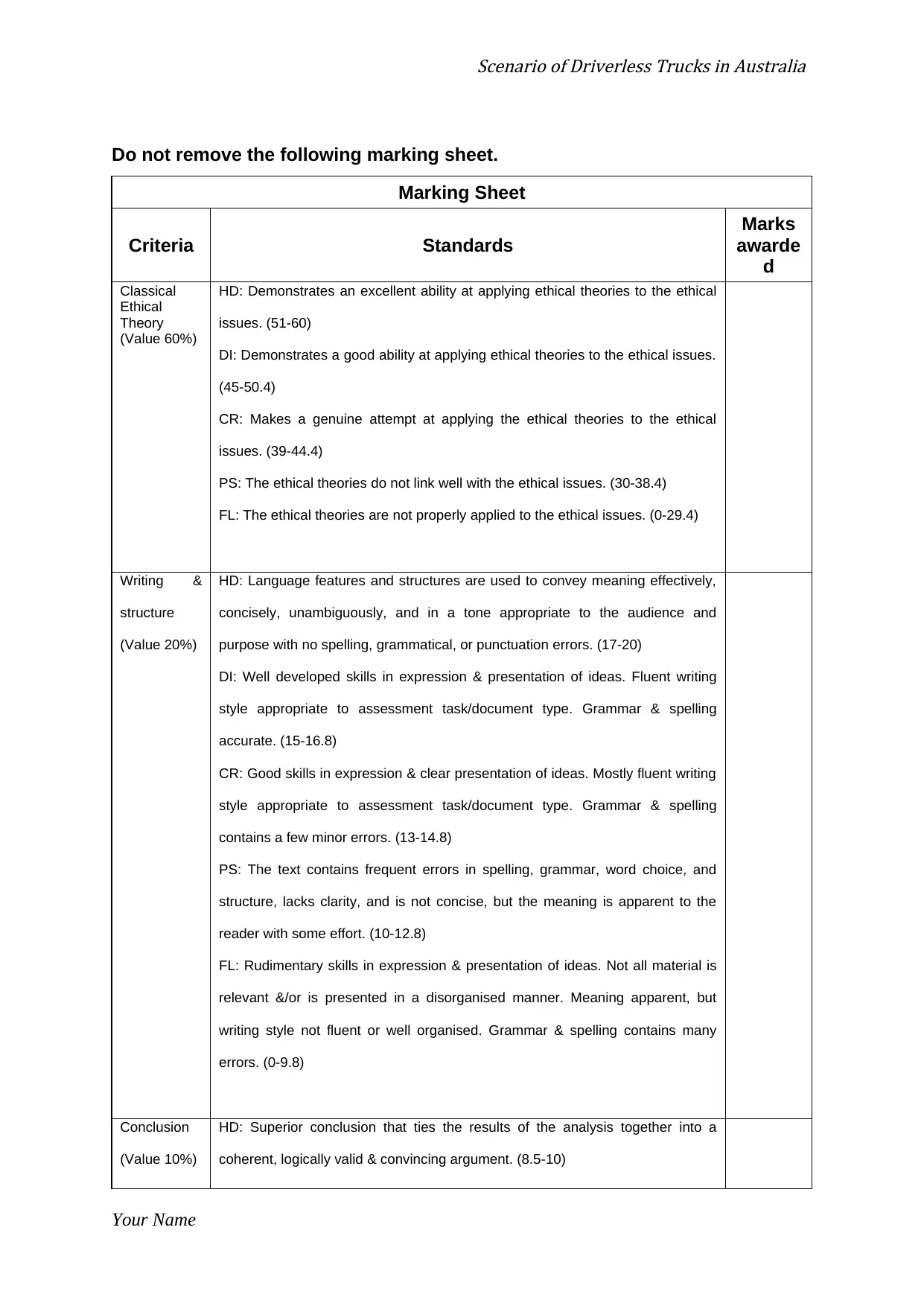
Scenario of Driverless Trucks in Australia
Do not remove the following marking sheet.
Marking Sheet
Criteria Standards
Marks
awarde
d
Classical
Ethical
Theory
(Value 60%)
HD: Demonstrates an excellent ability at applying ethical theories to the ethical
issues. (51-60)
DI: Demonstrates a good ability at applying ethical theories to the ethical issues.
(45-50.4)
CR: Makes a genuine attempt at applying the ethical theories to the ethical
issues. (39-44.4)
PS: The ethical theories do not link well with the ethical issues. (30-38.4)
FL: The ethical theories are not properly applied to the ethical issues. (0-29.4)
Writing &
structure
(Value 20%)
HD: Language features and structures are used to convey meaning effectively,
concisely, unambiguously, and in a tone appropriate to the audience and
purpose with no spelling, grammatical, or punctuation errors. (17-20)
DI: Well developed skills in expression & presentation of ideas. Fluent writing
style appropriate to assessment task/document type. Grammar & spelling
accurate. (15-16.8)
CR: Good skills in expression & clear presentation of ideas. Mostly fluent writing
style appropriate to assessment task/document type. Grammar & spelling
contains a few minor errors. (13-14.8)
PS: The text contains frequent errors in spelling, grammar, word choice, and
structure, lacks clarity, and is not concise, but the meaning is apparent to the
reader with some effort. (10-12.8)
FL: Rudimentary skills in expression & presentation of ideas. Not all material is
relevant &/or is presented in a disorganised manner. Meaning apparent, but
writing style not fluent or well organised. Grammar & spelling contains many
errors. (0-9.8)
Conclusion
(Value 10%)
HD: Superior conclusion that ties the results of the analysis together into a
coherent, logically valid & convincing argument. (8.5-10)
Your Name
Do not remove the following marking sheet.
Marking Sheet
Criteria Standards
Marks
awarde
d
Classical
Ethical
Theory
(Value 60%)
HD: Demonstrates an excellent ability at applying ethical theories to the ethical
issues. (51-60)
DI: Demonstrates a good ability at applying ethical theories to the ethical issues.
(45-50.4)
CR: Makes a genuine attempt at applying the ethical theories to the ethical
issues. (39-44.4)
PS: The ethical theories do not link well with the ethical issues. (30-38.4)
FL: The ethical theories are not properly applied to the ethical issues. (0-29.4)
Writing &
structure
(Value 20%)
HD: Language features and structures are used to convey meaning effectively,
concisely, unambiguously, and in a tone appropriate to the audience and
purpose with no spelling, grammatical, or punctuation errors. (17-20)
DI: Well developed skills in expression & presentation of ideas. Fluent writing
style appropriate to assessment task/document type. Grammar & spelling
accurate. (15-16.8)
CR: Good skills in expression & clear presentation of ideas. Mostly fluent writing
style appropriate to assessment task/document type. Grammar & spelling
contains a few minor errors. (13-14.8)
PS: The text contains frequent errors in spelling, grammar, word choice, and
structure, lacks clarity, and is not concise, but the meaning is apparent to the
reader with some effort. (10-12.8)
FL: Rudimentary skills in expression & presentation of ideas. Not all material is
relevant &/or is presented in a disorganised manner. Meaning apparent, but
writing style not fluent or well organised. Grammar & spelling contains many
errors. (0-9.8)
Conclusion
(Value 10%)
HD: Superior conclusion that ties the results of the analysis together into a
coherent, logically valid & convincing argument. (8.5-10)
Your Name
⊘ This is a preview!⊘
Do you want full access?
Subscribe today to unlock all pages.

Trusted by 1+ million students worldwide
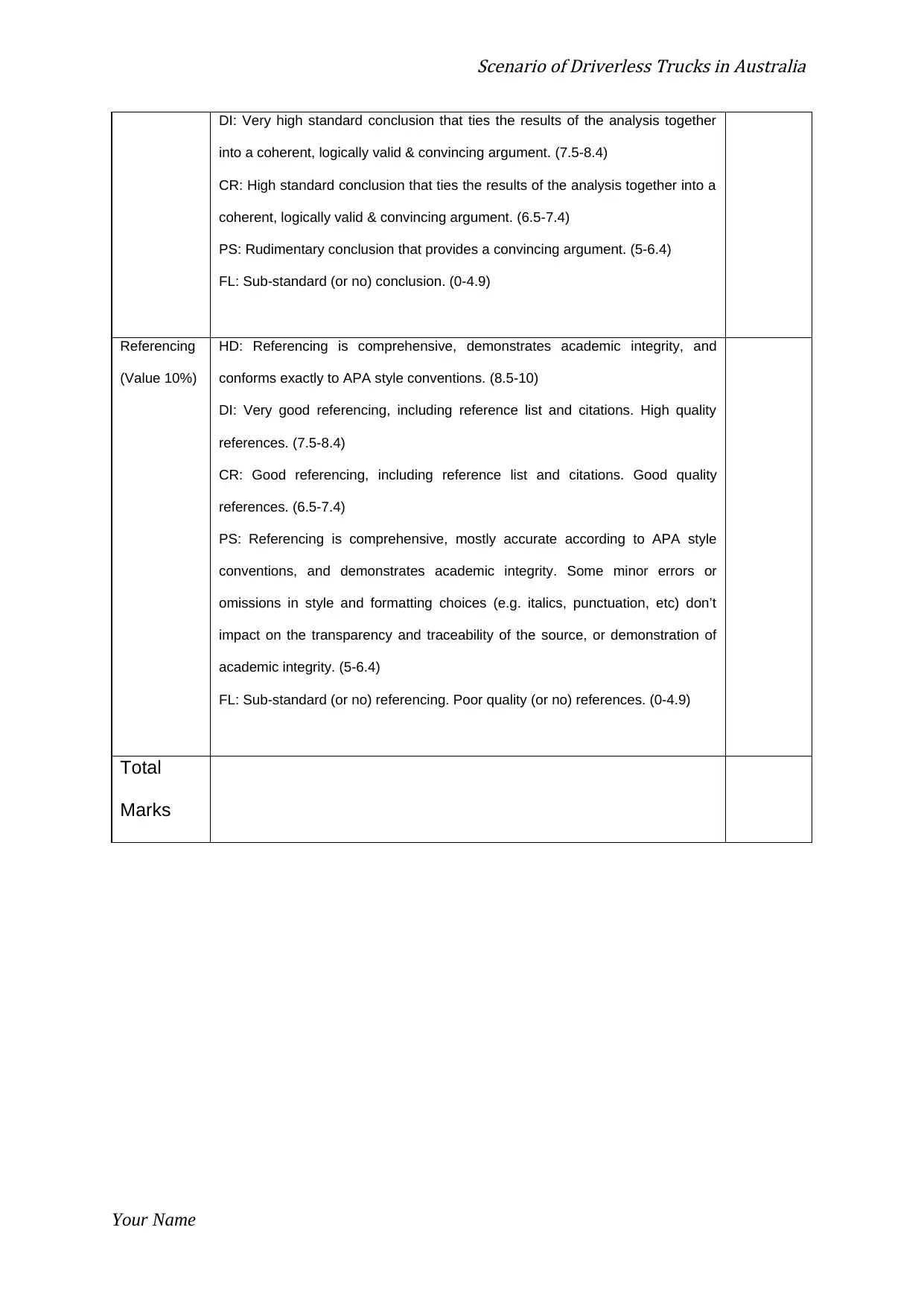
Scenario of Driverless Trucks in Australia
DI: Very high standard conclusion that ties the results of the analysis together
into a coherent, logically valid & convincing argument. (7.5-8.4)
CR: High standard conclusion that ties the results of the analysis together into a
coherent, logically valid & convincing argument. (6.5-7.4)
PS: Rudimentary conclusion that provides a convincing argument. (5-6.4)
FL: Sub-standard (or no) conclusion. (0-4.9)
Referencing
(Value 10%)
HD: Referencing is comprehensive, demonstrates academic integrity, and
conforms exactly to APA style conventions. (8.5-10)
DI: Very good referencing, including reference list and citations. High quality
references. (7.5-8.4)
CR: Good referencing, including reference list and citations. Good quality
references. (6.5-7.4)
PS: Referencing is comprehensive, mostly accurate according to APA style
conventions, and demonstrates academic integrity. Some minor errors or
omissions in style and formatting choices (e.g. italics, punctuation, etc) don’t
impact on the transparency and traceability of the source, or demonstration of
academic integrity. (5-6.4)
FL: Sub-standard (or no) referencing. Poor quality (or no) references. (0-4.9)
Total
Marks
Your Name
DI: Very high standard conclusion that ties the results of the analysis together
into a coherent, logically valid & convincing argument. (7.5-8.4)
CR: High standard conclusion that ties the results of the analysis together into a
coherent, logically valid & convincing argument. (6.5-7.4)
PS: Rudimentary conclusion that provides a convincing argument. (5-6.4)
FL: Sub-standard (or no) conclusion. (0-4.9)
Referencing
(Value 10%)
HD: Referencing is comprehensive, demonstrates academic integrity, and
conforms exactly to APA style conventions. (8.5-10)
DI: Very good referencing, including reference list and citations. High quality
references. (7.5-8.4)
CR: Good referencing, including reference list and citations. Good quality
references. (6.5-7.4)
PS: Referencing is comprehensive, mostly accurate according to APA style
conventions, and demonstrates academic integrity. Some minor errors or
omissions in style and formatting choices (e.g. italics, punctuation, etc) don’t
impact on the transparency and traceability of the source, or demonstration of
academic integrity. (5-6.4)
FL: Sub-standard (or no) referencing. Poor quality (or no) references. (0-4.9)
Total
Marks
Your Name
1 out of 10
Related Documents
Your All-in-One AI-Powered Toolkit for Academic Success.
+13062052269
info@desklib.com
Available 24*7 on WhatsApp / Email
![[object Object]](/_next/static/media/star-bottom.7253800d.svg)
Unlock your academic potential
Copyright © 2020–2025 A2Z Services. All Rights Reserved. Developed and managed by ZUCOL.




